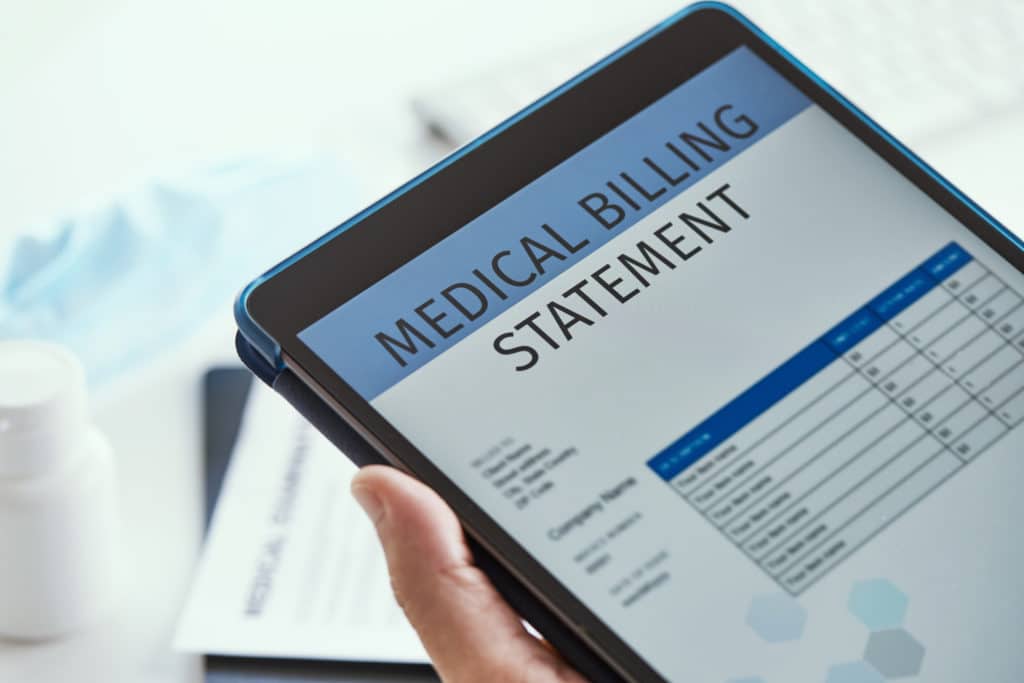These days, billing can be complex. There are lots of rules and details to keep track of. Good software helps with all of this. It makes billing simpler and more accurate.
The medical billing market is growing fast. The market was valued at USD 13.5 billion in 2022. Experts say it could reach USD 44.43 billion by 2032.
This growth shows just how vital medical billing is becoming.
Choosing the right medical billing software is crucial in healthcare management. It’s a big part of how healthcare providers handle their finances. In this article, we’ll make choosing the right medical billing software easy.
According to EverHealth, one of the most important considerations is the software “must comply with healthcare regulations and standards, such as HIPAA (Health Insurance Portability and Accountability Act) in the United States, to ensure patient data is protected and privacy is maintained.”
We understand that every healthcare practice has unique needs. That’s why we’ll guide you through the essential features to look for and how to assess your own needs, and we’ll compare different options.
Understanding Medical Billing Software
Medical billing software helps healthcare providers send out and manage the bills for their services.
Modern medical billing software has revolutionized the old ways of billing. In the past, medical billing was often done by hand or with simple computer programs. Not only did this take a lot of time, but it was also easy to make mistakes.
Medical billing software comes with many helpful features. Some of these include:
- Automated Billing: It saves time by sending bills automatically.
- Insurance Claims Management: It handles insurance paperwork and tracks claims.
- Patient Portal: Empower patients to make appointments and payments online.
- Payment Processing: Manage patient payments and insurance reimbursements.
- Reporting Tools: Generate reports to track how the practice is doing financially.
Different healthcare facilities have different needs. For example:
- Small Clinics: They might need simple software. It should be easy to use and not too expensive.
- Large Hospitals: They often need more advanced features, like handling lots of patients and complex insurance claims.
- Specialty Practices: Places like a dentist’s office or a physical therapy clinic might need specific features to support the type of care they offer.
Key Features to Look for in Medical Billing Software
When choosing the right medical billing software, keep an eye out for these must-have features:
Claim Processing
Claim processing is very important. It helps send bills to insurance companies. Good medical billing software makes this quick and easy. This means less waiting for payments.
Fast claim processing leads to quicker payments, improving cash flow for the practice.
Compliance Tracking
Compliance tracking keeps track of laws and rules. Medical billing must follow these rules. The right medical billing software will help you stay out of trouble by following these laws.
It reduces the risk of legal issues and fines, ensuring the practice operates according to legal guidelines.
Patient Billing
Patient billing allows you to send your patients accurate invoices in an easy-to-understand format. Clear bills also mean fewer patient queries and disputes, saving time for staff.
Reporting Tools
Reporting tools generate reports about your practice’s finances. These reports provide insightful information regarding your practice’s revenue and spending. This information is crucial for making informed financial decisions for the practice.
Automated Reminders
Automated reminders are helpful. They remind staff when to do important tasks like sending bills or following up on unpaid ones. This helps keep everything on track.
Automated reminders reduce the chances of missing critical billing deadlines, enhancing efficiency and improving cash flow.
Secure Data Storage
Secure data storage keeps private patient information safe. Good software protects this data from being seen by the wrong people. This not only protects patient privacy but also complies with data protection laws.
Customization Options
Every medical practice is different. Customization options let you change the software to fit your needs. Being able to adjust settings helps the software work better for you. Customized solutions mean more effective and specific workflow management.
Integration with Other Systems
Integration means the software can work with other programs you use, like your electronic health records (EHR) or scheduling systems. This ensures all your systems work together smoothly. It also streamlines operations and minimizes the need for multiple data entries.
User-Friendly Interface
A user-friendly interface is intuitive. It means your staff won’t need a lot of training to understand the software. This saves time and makes work easier. An easy-to-navigate interface also reduces errors, improving overall billing accuracy.
Benefits of Implementing the Right Software
Is investing in the right medical billing software worth it? Absolutely.
With the right strategy, you can enjoy the following benefits:
Improved Revenue Cycle Management
With the right medical billing software, managing money becomes easier. Bills go out faster, and payments come in quicker.
A study by The Beryl Institute shows that nearly two-thirds of healthcare organizations focus on improving experiences, including financial interactions. Faster billing can be part of this improvement.
RELATED ARTICLE: Top Trends & Statistics in Medical Billing
Reduced Billing Errors
Errors in billing can be a big problem. When medical bills have errors in them, patients are less likely to trust future bills. This can slow down the payment process and negatively impact cash flow.
Good medical billing software reduces billing mistakes. With clear and accurate billing, patients have fewer questions which leads to faster payments.
Better software helps avoid these errors, making everything smoother.
RELATED ARTICLE: 5 Tips for Better & Faster Medical Billing
Enhanced Patient Satisfaction
Happy patients are essential to your long-term success
Easy access to care and privacy are top concerns for patients. CVS Health’s study found that 89% of adults value these highly.
Good medical billing software can make scheduling and privacy management better, increasing patient happiness.
Better Patient Communication
Communication with patients is vital. One study found that 68% of patients want better interaction with their providers.
The right software can improve communication with your patients. Automated reminders for appointments and medications allow you to stay in touch without making tons of phone calls.
Compliance with Regulations
Following healthcare regulations is critical to the success of your practice. The right software helps practices stay compliant. This reduces the risk of legal issues and keeps patient information safe.
Addressing Wait Times
Long wait times frustrate patients. Efficient software can help manage schedules and reduce wait times, improving the overall experience.
Hassle-Free Scheduling
Patients want to be able to schedule appointments easily. User-friendly software simplifies this process, making it more appealing to patients.
Evaluating Your Practice’s Needs
When choosing medical billing software, think about what your practice really needs.
Here are some things to consider:
- Practice Size: Is your practice big or small? Larger practices might need more complex software.
- Patient Volume: How many patients do you see? More patients mean more bills to handle.
- Specialty-Specific Requirements: Determine if your specialty requires any additional needs.
- Types of Insurance: What kinds of insurance do your patients use? You need software that can handle all of them.
- Staff Skills: Consider how tech-savvy your staff is. Choose software that everyone can use easily.
- Budget: How much can you spend? More features might cost more.
- Future Growth: Will your practice grow? Pick software that can grow with you.
Comparing Different Medical Billing Software Options
Think about these points when comparing software. This will help you find the best one for your practice.
- Cost: How much does the software cost? Check if it fits your budget. Remember, sometimes cheaper options may not have everything you need.
- User-Friendliness: Is the software easy to use? It’s important that your staff can learn it quickly.
- Customer Support: Does the software company offer help when you need it? Good customer support can make a big difference.
- Integration with Other Systems: Can the software work with other programs you already use?
- Features: Look at what features each software offers. Does it have everything your practice needs?
- Reviews: What do other users say? Look for reviews to see if others like the software.
- Trial Periods: Can you try it before you buy it? A trial period lets you test the software to see if it’s right for you.
Making the Decision
Now you know what your practice needs and what software is out there. It’s time to choose.
Here are some tips:
- Think About Your Finances: How much can you spend? Choose software that fits your budget.
- Think About the Future: Will your practice grow? Choose software that can grow with you.
- Ask Around: Talk to other clinics using the software you like. See if they recommend it.
- Consider Integration: Make sure it works with your EHR or other systems. This saves time and effort.
- Chat with Your Staff: They’ll be using it every day. Ask them what features are important to them.
RELATED ARTICLE: 2023 Practice Management Software Buyer’s Guide
Be sure to avoid these common pitfalls:
- Rushing: Take time to understand your needs before you start looking.
- Only Caring About Price: It’s important but not the only thing. Features and ease of use matter, too.
- Not Asking for Help: Talk to other clinics and get demos to see what’s out there.
- Ignoring Your Other Systems: Choose software that works well with your EHR or other programs.
Implementing Your Chosen Medical Billing Software
After choosing your software, it’s time to put it to use.
Here’s a simple step-by-step guide:
- Installation: First, install the software on your computers. This might be done by the software company or your IT team.
- Data Migration: Next, move your old records to the new system. This can be a big job, so it’s essential to plan it well.
- Staff Training: Teach your staff how to use the new software. Maybe set up training sessions or workshops. Make sure everyone understands how it works.
- Testing: Before you start using it in your day-to-day operations, test the software first. Check if it’s doing everything it should. This helps find problems early.
- Going Live: Now, start using the software in your daily work. Keep an eye on how things go for the first few days.
- Regular Updates: Keep your software updated. New updates can add features, fix problems, and boost security.
Overcoming Implementation Challenges
Sometimes, you might run into problems. Here’s how to deal with them:
- Learning New Things: If staff struggle with the new software, give them extra help. Maybe create a help guide or set up a helpdesk.
- Data Transfer Issues: When moving data, double-check everything. Make sure all important information is moved correctly.
- Technical Problems: If there are computer issues, get help from an IT expert.
- Adjusting to Change: Change can be hard. Encourage your team. Listen to their worries and help them adapt.
Partnering with a medical billing software company can have tremendous benefits for healthcare organizations, both in terms of process efficiency and financial stability.
By working with a software provider that offers comprehensive training and implementation services, healthcare providers can gain a deeper understanding of the software’s capabilities, resulting in smoother adoption and utilization.
Additionally, access to a dedicated customer success expert and a knowledge base of resources can ensure timely solutions to issues and ongoing support.
Utilizing a software provider that offers secure data moves and file delivery can provide peace of mind knowing that patient data is always safe and compliant.
Overall, partnering with the right medical billing software company can help healthcare providers optimize their revenue cycle management processes and improve patient care.
The Long-Term Benefits of Medical Billing Software
When you use the right medical billing software, it can really help your healthcare practice in the long run. Here’s how:
Smoother Financial Management
The software makes handling money much easier. It can track bills, payments, and insurance claims all in one place.
Over time, this means your practice can manage its finances better and more clearly.
Saving Time and Effort
With this software, many tasks are automated. This saves a lot of time for your staff. They don’t have to do everything by hand. They can focus on caring for patients instead.
Fewer Mistakes
Since the software handles many things, there are fewer chances for mistakes. This is important because errors in billing can cause problems for both patients and providers.
With fewer errors, your practice runs more smoothly.
Better Patient Relationships
Patients like it when things are clear and easy. Good software makes billing and scheduling simpler for them. This can make patients happier with your practice.
Ready for Growth
If your practice grows, the software is ready for it. It can manage more patients and more complex tasks. This means you’re set up for a successful future.
Discover the Power of CMD: Streamlining Your Medical Billing Process
Looking for great medical billing software? Check out what CollaborateMD has to offer.
CollaborateMD’s -medical billing software is perfect for any medical practice or billing company. CollaborateMD is HIPAA compliant and offers a variety of features that help you get paid faster, including:
- Claim Generation and Submission: This makes sure your claims are right and follow insurance rules. It also sends them out quickly.
- Charge Capture: This integration with our app keeps track of patient notes, billing codes, and more.
- Electronic Remittance Advice (ERA): ERA gets rid of paper EOBs. It provides digital info about claim payments. This helps you get paid faster and make fewer mistakes.
Interested in learning more about how CMD Medical Billing Software can improve your billing process? Schedule a demo today!
Take Action with These 3 Tips
Here are three simple, no-cost tips you can use right away:
- Talk to Your Team: Ask your staff what they need in medical billing software. Their daily experience can give you great insights.
- Make a List: Make a list of what your practice really needs in billing software. This will help you when you compare different options.
- Do Your Research: Explore the various medical billing software options on the market. See what features they offer and read reviews.




